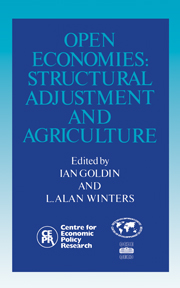Book contents
- Frontmatter
- Contents
- List of figures
- List of tables
- Preface
- Acknowledgements
- List of conference participants
- 1 Introduction: from macro to maize
- Part One Open economy analysis
- Part Two The small country assumption and trade reform
- 6 Exchange reforms, supply response, and inflation in Africa
- Discussion
- 7 Taxes versus quotas: the case of cocoa exports
- Discussion
- 8 Trade reform and the small country assumption
- Discussion
- Part Three Risk and adjustment
- Part Four Government's role
- Index
Discussion
from Part Two - The small country assumption and trade reform
Published online by Cambridge University Press: 04 August 2010
- Frontmatter
- Contents
- List of figures
- List of tables
- Preface
- Acknowledgements
- List of conference participants
- 1 Introduction: from macro to maize
- Part One Open economy analysis
- Part Two The small country assumption and trade reform
- 6 Exchange reforms, supply response, and inflation in Africa
- Discussion
- 7 Taxes versus quotas: the case of cocoa exports
- Discussion
- 8 Trade reform and the small country assumption
- Discussion
- Part Three Risk and adjustment
- Part Four Government's role
- Index
Summary
In Chapter 7, the world cocoa market is treated by the authors as an oligopoly with nine players/countries. The alternative forms of the market considered are the Nash tax game (in which countries fix export taxes, taking the tax levels of other countries as given and unchanging), the Nash quota game (in which countries fix national quotas, taking the quota levels of other countries as given) and Stackelberg quantity leadership with the Côte d'lvoire, which supplies about one-third of the world's supply, as the Stackelberg leader. These three game forms give different quantities traded and profits traded for each of the nine countries. However, they can be summarised by considering the aggregate ‘profits’ for all nine countries. They are – in descending order of aggregate profits – Nash quantity, Stackelberg quantity and Nash tax. This is consistent with the theory. We know that the Nash quantity must rank – from the point of view of the supplying countries – above the Nash tax solution because the aggregate quantity supplied is less. This follows in turn because the reaction curves in quantity space are negatively sloped (and thus one country reacts to a greater quantity supplied by others by reducing its quantity), whereas the reaction curves in price space are positively sloped (and one country reacts to a greater quantity (lower tax) supplied by others by increasing its quantity (lowering its tax)). We know, too, that a Stackelberg quantity leadership will increase the profits of the Stackelberg leader compared to the Nash quantity solution and reduce the profits of the others collectively, and it turns out that the aggregate quantity supplied is greater under the Stackelberg quantity game.
- Type
- Chapter
- Information
- Open EconomiesStructural Adjustment and Agriculture, pp. 170 - 171Publisher: Cambridge University PressPrint publication year: 1992



